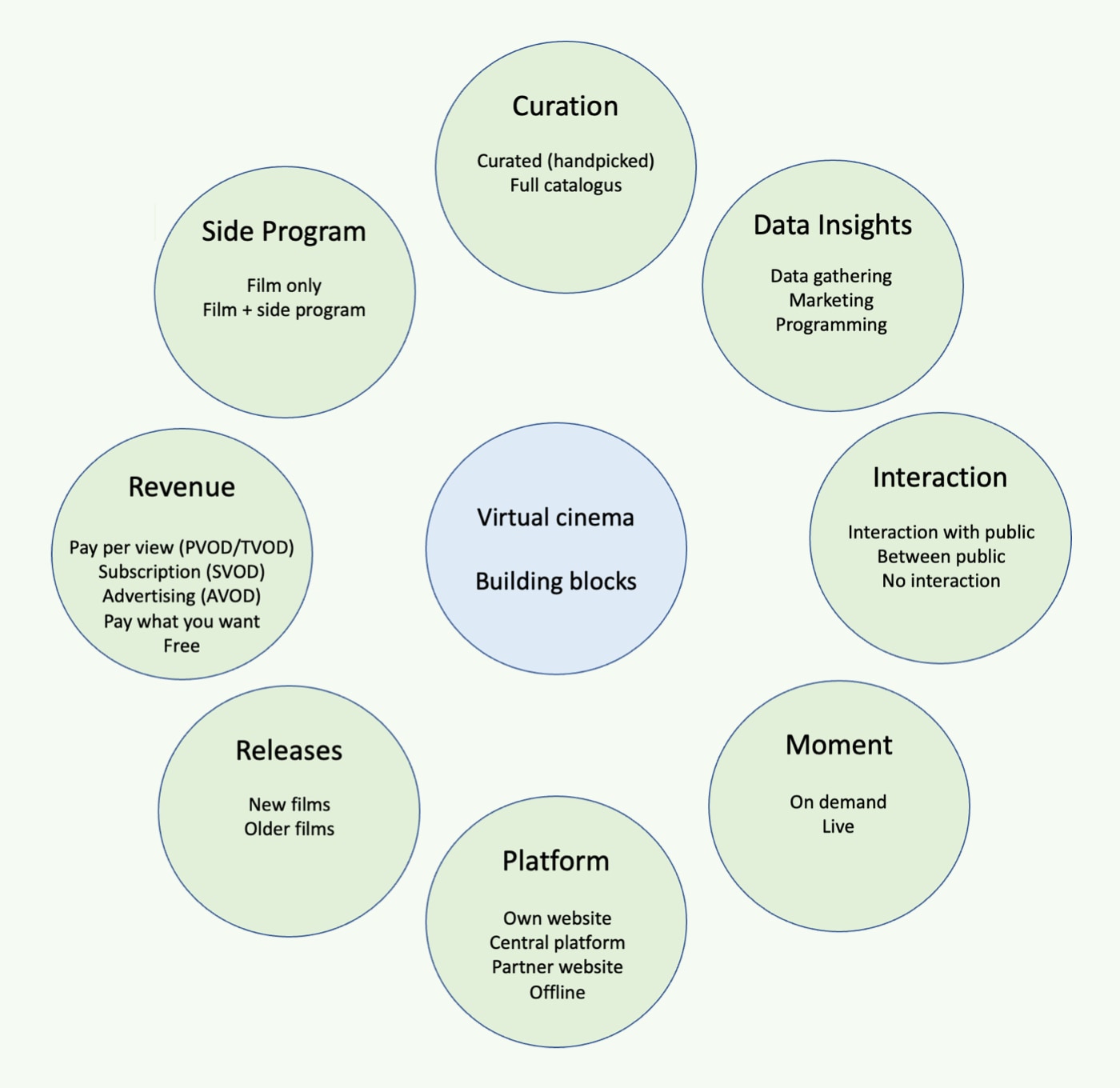How to love your digital screening room more and more
There was no doubt about it. During the COVID-19 pandemic, we cried out confidently that “hybrid was here to stay”. It is safe to say that working remotely has indeed proven to stick around. But at film festivals and in cinemas we see that in 2023 the focus was on one thing: getting the theaters filled with physical visitors again. You can’t blame them: the digital auditorium has not proven yet to be a pot of money and it turned out to require specific attention and manpower in terms of programming, communication and technology. But if you ask European cinemas and distributors about the role of online film in the future, everyone seems to be unanimous: the belief in the potential of virtual cinema is still there and they expect it to only grow. So how to deal with virtual cinema then, post-pandemic? In this article series by Janneke van Laar from Medialoc, one of the initiators of the REACH’M project, a selection of tips and concrete practical examples for film exhibitors who (want to) screen films online and would like to experiment further. A selection from our experience of recent times, to make you love your digital screening room more and more.
—
#2: What we can learn from Europe
Barbie, The Super Mario Bros. Movie and last year’s Avatar. These hits from the States, plus a sweet bunch of successful French titles, made France’s box office hit no less than 181 million ticket sales in 2023. The French have always been known to be fond cinema goers, so it’s no massive surprise that the French box office, according to figures from the CNC, leads Europe in last year’s post-pandemic recovery. While still somewhat below their usual average, French cinema visits seem to have resisted the aftermath of the pandemic better than any other box office in Europe.
So far the physical box office. But what is happening in Europe’s virtual cinema these days? In order to find out, the REACH’M team (a collaboration between Picl and Medialoc with the support of Creative Europe) initiated a research to map the current state of virtual cinema in Europe. What are the experiences and obstacles encountered by European cinemas and distributors in shaping their virtual cinema business models? And what are the opportunities perceived for the future of virtual cinema?
“Fuelled by the lockdowns that made new forms of reaching audiences possible, as well as rapidly increasing technical capabilities, there have been many new initiatives in this field. Some more successful than others. We now thought it was time to evaluate and look forward to what’s next.”
Noortje van de Sande (Picl)
The current state of virtual cinema in Europe
From Belgium to Estonia, and from Sweden to Spain. In our research, a total of 77 cinemas and 52 distributors from 25 different European countries took part, offering us an insightful view on the current state of virtual cinema in Europe. Around 50 percent of these parties have (had) some form of virtual cinema on offer. In this article, we assembled the most interesting findings and best practices for you. If you want to take a deeper look into the results, you can find the full report of the research here.
So, what’s cooking in Europe? Overall, the study shows that European cinemas as well as distributors see opportunities in virtual cinema. Plus, they feel that the virtual cinema situation is looking for a new equilibrium after the period of COVID-19.
“This result gives us the confidence that cinemas as well as distributors are looking towards the long term as it comes to content strategy and hybrid audience reach.”
Anke van Diejen (Picl)
All in all, there are three main takes we can distillate from the research:
- It’s not all about the money
- Expertise is everything
- There is no one size fits all model
Take 1: It’s not all about the money
As we already explored in our article “It all starts with your identity”, one can use virtual cinema to create additional value. For instance in deepening your content, increasing your audience reach or in the growth of your reputation. As shown by the research, the turnover of virtual cinema for most respondents often is financially not very significant. When talking about the business model in our research, we therefore refer to a model that is not solely focused on the financial aspects, but rather on the question of how an organization makes sure that it is valuable to its stakeholders. Of course the revenue model is part of a business model, but it would be a true waste if we would see the value of virtual cinema only in monetary terms. According to the research, the biggest added value of virtual cinema lies in:
- The opportunity to offer a broader range of programming
- Providing an additional service to the customers
- Gathering data and insights
Take 2: Expertise is everything
Furthermore, the research showed that in order to really be of value for audiences and the industry in general, knowledge on certain specific areas need to be developed and shared. For cinemas and distributors, these areas include financial aspects and applications for subsidy, but also on know-how regarding marketing when deploying virtual cinema. Especially as they often lack certain capabilities or capacities for organizing and offering virtual cinema, they need external support. In terms of where they need support, one cinema in our research responded “exchange of good practices about linking extra online content (video introductions, podcasts, longreads … ) to the film program, maybe even exchanging the content itself,” and a distributor stated “building a robust toolkit for VC partners to use.” Also, the respondents voiced a clear need to have a better understanding of the possibilities of utilizing the data that is generated through an online viewing service. Issues of data management, big data and how to generate actionable consumer insights are for many players in this field not something they can tackle with their often limited resources. There seems to be a strong need for more and innovative knowledge on issues concerning the virtual cinema business. And this knowledge could and should be shared with peers.
“We need to anticipate the future of online and hybrid screening. To continue contributing to the changing needs of audiences and thus the reach of European arthouse film, exploring and experimenting is essential. We need to continuously be thinking ahead to create a future-proof and competitive environment for European cinemas and films.”
Frank van der Horst (Medialoc)
Take 3: There is no one size fits all model
The solution for a good and viable business model in this field is not singular. In some countries there are particular challenges, such as in Italy, where virtual cinema is not officially recognized in legislation when it comes to the (first) theatrical window and where the general audiences consider online content of lower value. In other countries there are factors that actually strengthen the possible success of virtual cinema, such as an excellent internet connection which enlarges possible success for reaching an online audience and the availability of already existing central VOD platforms one can join that offers cinemas and distributors the possibility to share revenue (like the KinoVODClub in Austria en Picl in the Netherlands). It is evident that each situation, each country or region asks for its own answer that adheres to the particularities of each market, legislative reality and to the personal ambitions of the involved organizations.
Some hands-on best practices
Talking to so many European parties for this research, we ended up with a handy list of concrete tips and tricks in the slipstream, with some fresh ideas on how to shape your virtual cinema.
- Make room for those films that cannot find an audience due to a lack of space for them in cinemas.
- Reach out to those who cannot visit a cinema.
- For distributors and producers in particular: create one file with multiple subtitles, which allows you to be able to reach out to multiple countries and audiences, saving on hosting and streaming costs as well.
- Consider joining a central platform, instead of hosting your own virtual cinema. This can be more efficient and can have additional benefits, such as increased visibility and being part of a collaborative network. It can still enable supporting individual cinemas, as in the case of Picl.
- Make use of new innovations in virtual cinema that have rapidly emerged during the pandemic. The Offline Stream Player by Medialoc is such an example, a technique using streaming technology to facilitate encrypted non-DCP screenings in an affordable and doable way.
- Offer a free movie ticket for a (physical) cinema visit in combination with online visits or subscriptions. People usually bring somebody along, which leads to additional revenues for the cinema.
- Extend the life cycle of a film or a festival program online.
- Extend and deepen your offer with retrospectives from directors with premiered films.
- Use your digital screening room for other types of media as well, covering festivals, events and regional production.
- Increase the engagement with your audience, for example with live or interactive tools.
- Experiment! In our study we introduced eight building blocks (see below) for designing a unique business model configuration that is suited for a particular situation. By experimenting with the choices within these building blocks, cinemas, distributors or platforms can find the configuration that best serves their situation and ambitions, and be of optimal value to themselves and their audiences.

Do you need some help in experimenting with these choices? Not sure where to start or which approach suits you best? Medialoc recently developed a toolkit that will help you get started: https://toolkitvirtualcinema.eu/. It was developed to help cinemas and distributors make those choices. Each chapter of this toolkit is organized according to a theme, from audience to programme. For each theme, the main conclusions from the research are shared, provided with possible choices, practical tools and real-life examples. This gives you a broader picture of the possibilities of virtual cinema and makes it easier to choose the building blocks that lead to a suitable business model. That is: a business model that suits your specific needs. There are no ready-made solutions, but there are all kinds of possibilities. So use this toolkit mainly as a guide to start the discussion internally and externally and to further shape virtual cinema.
—
We would love to hear what your online and hybrid plans, questions and ambitions are. In any case, we are ready for you with lots of online ideas and experience! We would love to think with you. Please reach out to us via janneke@medialoc.eu.

